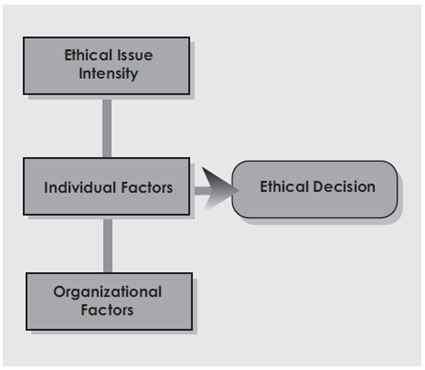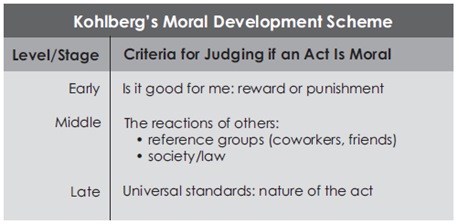April 2017 — It is one thing to understand about moral standards and theories of ethics as applied to business. However, other factors must be considered. It is helpful to understand how you make decisions and to know how the decision making of fellow team members, managers, and leaders, takes shape.
There are factors that can influence or undermine the best intentions. This often explains why individuals who live exemplary lives outside their jobs sometimes behave unethically in the workplace. The following figure presents a model—developed from the work of O.C. Ferrell, John Fraedrich, and Linda Ferrell—of what causes professionals to act unethically.
Ethical Issue Intensity
Ethical issue intensity pertains to the awareness among employees that certain issues have an ethical component to them. It considers how important these issues are to an organization, and how the organization wants employees to behave when those issues arise. Awareness is created through ethics training, codes of ethics, and communication and actions from the top down.
For example, a company that does business overseas may provide training about bribes. The training will make it clear to employees that accepting bribes from representatives of foreign governments is unacceptable. The training will explain why this is so and how to respond when solicitations are made.
Individual Factors
The individual factors in this model pertain to character, psychological influences, and moral development. When we say character, we are referring to an individual’s moral strength, which is determined by examining his or her pattern of actions over time. A person who is consistently honest, respects the rights of others, and is generally virtuous—even when no one is watching—is considered to have strong character. Good or bad, our moral character is something we bring with us to the workplace, and it influences choices we make that have ethical implications.
Two psychological influences play an important role in ethical decision making: conformity and commitment. Conformity is the desire to not be seen as different than the majority of those in a group. High school students are notorious victims of conformity. But even among adults, the draw to fit in can be hard to deny. If cutting corners and filing false expense reports is how most employees operate within a company, the pressure will be great to conform.
Commitment is closely tied to conformity. Members of any group are expected to be committed to the goals of that group. If management believes an employee is out of step with the company’s goals or methods of achieving them, efforts may be made to get that employee to conform. Harsh evaluations, lack of advancement, demotions, and the threat of dismissal are possible tactics. A morally upstanding employee, pressured by an executive to cut corners on work quality, might have a hard time resisting the words Are you with us or against us?
Moral development, the third individual factor, is the degree of sophistication that an individual has when it comes to discerning if an action is morally right. According to Lawrence Kohlberg, whose theory of moral development has influenced many thinkers on this topic, we pass through a series of stages in life regarding our ability to reason about morally good and bad behavior. The following figure illustrates Kohlberg’s theory.
The more highly developed our thinking, the more capable we are of seeing the broader impacts of our decisions and the more universal issues involved. An individual operating in Kohlberg’s lowest (simplest) stages of reasoning would judge right and wrong based solely on how the decision would affect him or her. Right actions are those that lead to positive consequences or the lack of negative ones for the individual.
For example, a property manager deciding whether or not to accept a bribe from a potential cleaning service contractor would ask himself, What could happen to me if I do this? Will I get caught? Will that mean losing my job?
An individual operating in the middle stages of moral reasoning would be able to see broader implications of decisions. An immediate reference group becomes the source of right and wrong.
That same property manager, deciding whether or not to accept a bribe, would ask himself, What would other property managers do? What would employees in my company think I should do?
As individuals progress in their reasoning, but are still in the middle stage, they become able to judge right and wrong in terms of the society in which they exist. There is the understanding that a society cannot function without a set of rules, based on morality, by which we must conduct ourselves. The property manager in this example would reason, It is wrong to accept a bribe because our society has deemed that bribery is illegal. Rules such as this have been created because they are in the interest of the general well-being. If business and government in our society allowed bribery, those institutions would not function well, and we all would lose out in the end.
In the final and most advanced level of reasoning, individuals see that the rightness or wrongness of an action exists outside the framework of a society. It is a function of the essence of the action itself. Telling the truth, for instance, is correct because truth-telling is inherently right. Thus, one does not depend solely on the law in making judgments on right and wrong. The property manager would be able to reason that inherent in being an employee is the core moral obligation of fidelity, or loyalty to the employer. He would be able to judge that keeping a promise is a moral duty.
Organizational Factors
The final piece in the Ferrell, Fraedrich, and Ferrell model is the organizational context, which can influence even the most virtuous individuals to behave in ways contrary to their moral value system. Organizational factors include culture, immediate work group, and opportunity.
In particular, the corporate culture of an organization can wield enormous power over how individuals make moral choices. For our purposes, corporate culture is the set of values and beliefs of a company, including our history and traditions. It is often expressed in a company’s mission statement, but is also communicated by actions, especially from the top down.
Organizations that have a history of treating employees, business partners, customers, and the public in an honest and fair manner are expressing one kind of culture. Those that are disrespectful of these groups are expressing another. Companies that have an ethical culture are more likely to positively influence ethical decision making by employees.
While the official ethical standards of an organization are contained in codes of ethics and conveyed in training and written documents, those items are often interpreted through the words and actions of our immediate work group.
Consider the example of a company with strict standards about not accepting gifts from potential or existing service providers. However, you learn that your coworkers break those rules so regularly that it has become custom to do so. You come to see accepting such gifts as right, even though the company’s official position is that it is wrong. Thus the immediate work group’s influence often overrides the official standards of the organization.
Ultimately, acting ethically requires self-awareness. The factors that impact perceptions of right and wrong must be understood—and respected.
This article is adapted from BOMI International’s Ethics Is Good Business® ShortCourse™, part of the RPA and FMA designation programs. More information regarding this course or BOMI International’s new High-Performance Sustainable Buildings credential (BOMI-HP™) is available by calling 1-800-235-2664. Visit BOMI International’s website, www.bomi.org.

